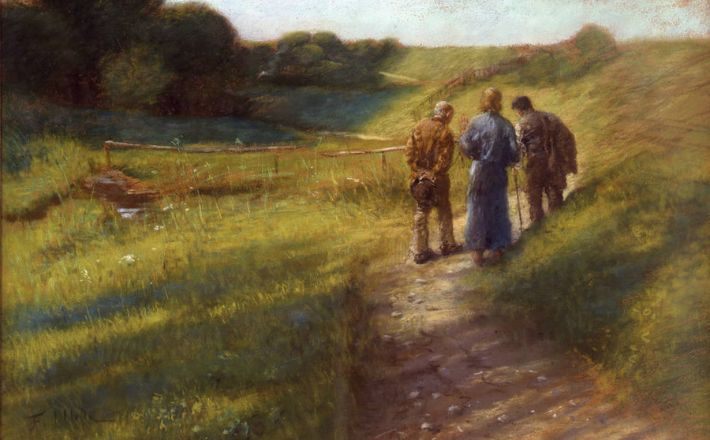Commentary on Luke 24:13-35
We do not usually tell ghost stories in church, but this road-to-Emmaus story is exactly that—a ghost story. It has all the elements of a good ghost story: A shadowy figure of a dead person appears and disappears at random moments; strange otherworldly events are afoot; something we learn from those otherworldly events fundamentally changes real life. While we usually think of ghost stories as fictions told around the campfire, there is another context in which “ghost stories” enter our lives: those times when our grief for someone gone calls their presence to us in palpable ways. In these moments, “ghost stories” tell us something about our grief; they are often “grief stories.”
The Emmaus Road travelers, deep in their own grief, experience this kind of “ghost story” in this morning’s reading—only with a twist. The previous group of disciples are still in Jerusalem processing Mary Magdalene’s news of the empty tomb and the angels’ announcement (verses 1–12). While resurrection stories most often call to mind the 11 male disciples (now that Judas was not with them), plus Mary Magdalene, Joanna, Mary the mother of James, and the other women, others knew the Jesus story, were part of the movement, and were preachers of its resurrection faith. These other disciples rarely make it into our usual stories about Jesus’ death and resurrection.
The story of the Emmaus Road travelers gives preachers the opportunity to call these disciples into the center of the story. (Think also of the 72 disciples who were sent out two by two in Luke 10:1–23.)
Cleopas and his companion were likely very scared about their future. They had seen the brutality of which the Romans were capable. They were not the most immediate targets of this Roman cruelty, but they were attuned to the stories of those who were. They were probably trying to figure out what to do next. Luke does not say why they were heading to Emmaus, only that it was about seven miles (or a half-day walk) from Jerusalem. They were, however, processing all that had happened in the previous days.
Luke, the narrator, tells us that Jesus joined them on the road, “but their eyes were prevented from knowing him” (verse 16). This intervention of Luke’s voice shifts our perception of the meeting from one of grieving travelers encountering a know-it-all stranger to the resurrected Jesus teaching his disciples another lesson. One angle for preaching would be to imagine what it would have been like to be Cleopas and his companion without the advantage of Luke’s narrative knowledge.
There are a few things we know about Cleopas and his friend. They had been in Jerusalem during Jesus’ trial and crucifixion, and now they had heard the rumor-mill chatter about the empty tomb (verse 18–20). The circles they knew in Jerusalem included those we know as the 12 apostles and the women with them. They, like their acquaintances, recognized Jesus as a “man, a prophet powerful in deed and word before God and all the people (laos)” (verse 19). They also had hoped, like many others, that Jesus would be the one to ransom (lytroō) Israel. It is clear from the syntax of the sentence that they no longer hold this hope.
Of course, they do not know the irony of which they speak. And preachers should be careful not to download two millennia of theological (and controversial) meaning onto lytroō. Likely, neither Luke nor the travelers of our inquiry were thinking cosmologically about atonement for sin. Likely, they understood this verb as a ransom in exchange for political autonomy from the Roman Empire. Rome’s reach into the workings of the Jerusalem temple and its wealth, land, and people created significant tension among the people of Jerusalem and of the region. Cleopas and his companion likely hoped for Jesus to bring peace by banishing the Romans and unifying the people. Now the report was that Jesus’ grave was empty (verse 24).
While Luke has already primed us as readers to see the folly of this report, the uncertainty of it for Cleopas and his companion needs to be met with empathy. Why would anyone think about resurrection and cosmic redemption within this set of circumstances? The horrors the Romans had already staged would make a grave robbery and desecration of Jesus’ body perfectly believable. A plot to make Jesus’ followers seem delusional would make political sense. A resurrected dead man who appeared with ghost-like unpredictability did not.
The problem is not that these travelers were naïve. The problem is that they knew too well the charades of the Romans, and in their understanding of Israel’s history, the prophets and kings, the anointed ones (messiahs), overthrew foreign regimes. Itinerant, crucified preachers did not.
As the three walk along, continuing toward Emmaus, traveler Jesus argues that the suffering and death of the previous days was all discernable in Moses and the prophets as the necessary path for the next anointed one, for himself (verses 26–27). Now, we as readers sometimes still fault Cleopas and his companion for not immediately accepting Jesus’ argument. This judgment on our part, however, assumes that disagreement is a sign of unfaithfulness. For Cleopas and his companion, Jesus’ reinterpretation is just another possibility in a sea of confusion, rumor, and speculation. We can easily imagine that the conversation continued with lively disagreement and many questions back and forth.
Once they stopped for the evening and prevailed upon Jesus to stay too, I imagine they were still deep in banter about the events in Jerusalem when Jesus, as the honored guest, began the meal with a blessing and shared bread. Then he disappeared. That is when they recognized him—as he vanished (verse 31). Luke reports this story as a kind of ghost story—a ghost story about this person who spoke like Jesus, acted like Jesus, was Jesus, and disappeared into thin air.
This is where the connections with Roman politics come full circle in the text. The Roman propaganda machine loved to tell ghost stories, especially about their emperors—those of the past and those still governing.1 These ghost stories, and even sometimes ghost stagings, were a way of making the emperor present without the actual person needing to travel. Throughout the Roman Empire, and likely even as far away as the places where Jesus lived, the Romans told stories about the emperor appearing at night to leaders, manipulating the gods of a local city to create alliances, inhabiting the statues that dotted the cities of the empire. In fact, archaeologists have found evidence of theatrically designed spaces where statues would “speak” directly to the people. In this way the Romans manufactured “ghosts” and also manufactured fear.2 Such fear further confused Cleopas and his companion. After all, part of the tension between Jesus and Pilate in the trial story is the fact that Jesus was called the basileus tōn ioudiōn (Luke 23:28). While we usually translate this phrase “king of the Jews,” basileus is also the Greek word for “emperor.” Jesus, his followers claim, is emperor of the Jews, a direct challenge to the Roman imperial hierarchy.
Here is where preachers might consider adding the story immediately following this morning’s assigned pericope: Luke 24:36–49. Cleopas and his companion return the next day to Jerusalem to tell their story to those still in Jerusalem (verse 35). Jesus appears again—and Luke says that everyone was sure this time that he was a ghost (verse 36). Since the Romans had tried and killed Jesus, and Jesus’ tomb was empty, it would not be unusual for stories to emerge about the ghost of Jesus appearing throughout the countryside. Listeners can identify with the idea that Jesus’ followers were likely a little skeptical about both of these ghost stories. Their fear had a very real political context and drew on their deep grief.
For modern readers, Jesus’ appearance seems to contradict that fear and grief. Sometimes we cannot live easily with such contradictions. Sermon listeners may not be able to connect with the joy of resurrection when the fear of their own ghosts or the grief of their own lives seems much more real. But in this second appearance of Jesus, preachers can point out that our fears, our grief, our memories of pain are just as real as the disciples’. While at times Luke, as the narrator, dismisses this fear, grief, and pain as just another chimera like the Roman emperor-ghosts, Jesus offers something different. Jesus speaks directly to them as their beloved, recognized teacher (verse 38–43). Jesus stands there among them, scars on his hands and feet, flesh and bones holding him in a familiar posture; his voice resonant, beloved, familiar in their ears; his hunger real as he asks for a snack. This is no ghost.
Indeed, Jesus assures them, he is no ghost at all. Luke relates their joy (chara) at this discovery, but mixes it up with their mistrust (apisteuō) and their wonder (thaumazō; verse 41). Joy, grief, befuddlement, suspicion are all swirled around each other in these stories of Jesus’ appearances. The complexity of these emotions and the stress of sorting out the story must have been very real—just like it is for listeners today, whether deeply rooted in faith or seeking something more.
Ultimately, Jesus teaches them what it meant for the Messiah to have suffered, died, and risen—that repentance and forgiveness, return and reconciliation, justice and mercy are God’s message for all nations (verse 47). Even this message is thoroughly a mix of joy, comfort, peace, and grief, separation, suffering.
Part of the preacher’s job in the Easter season is to assure people that death was not, is not, will never be the final word on Jesus’ life or ours. Even all mixed up in confusion and joy, Jesus’ appearances to these disciples commission them to tell more than mere ghost stories or memories of a bygone teacher. This unghostly Jesus promises power from God to tell the story of justice’s possibilities, of God’s mercy in the world, of enduring love (verse 48). As readers of the story, we find our place when Luke’s Jesus reminds us, “You are witnesses of these things” (verse 48).
Notes
- For examples of such stories, as well as the ways that Mark uses them, see Matthew James Ketchum, “Haunting Empty Tombs: Specters of the Emperor and Jesus in the Gospel of Mark,” Biblical interpretation 26 (2018): 219–243.
- A good example of such “speaking statues” is found at Pergamon in the Red Hall. See Charles Gates, Ancient Cities: The Archaeology of Urban Life in the Ancient Near East and Egypt, Greece, and Rome (Routledge, 2003), 386.
PRAYER OF THE DAY
Mysterious and Divine Presence,
Too often our hearts burn within us because our bodies know before our minds that you are here working in us and through us in this world. Open our eyes, and help us to recognize you in all places and in all people, for the sake of the one whose presence is never far, Jesus Christ. Amen.
HYMNS
I want Jesus to walk with me ELW 325, UMH 521, NCH 490
That Easter day with joy was bright ELW 384, H82 193
Come down, O Love divine ELW 804, H82 516, UMH 475, NCH 289
CHORAL
Come down O love divine, Donald Busarow


April 27, 2025